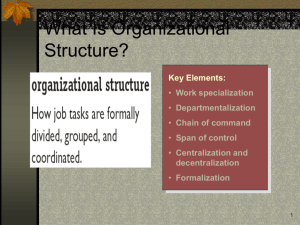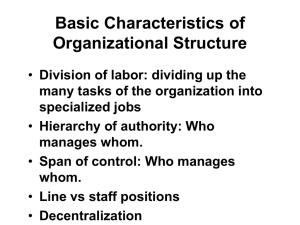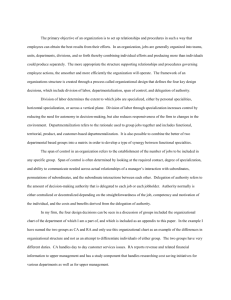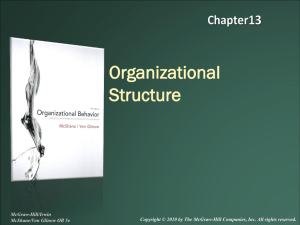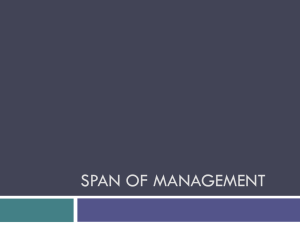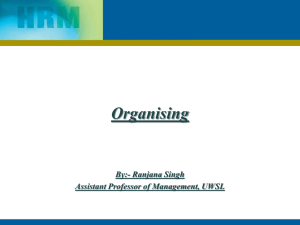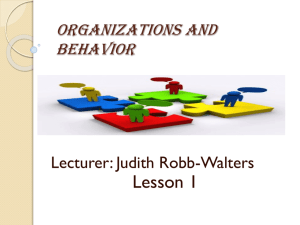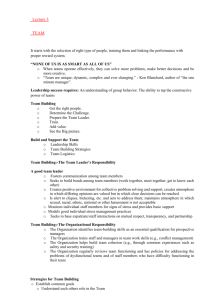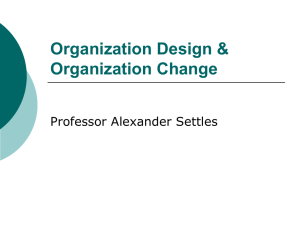Ch 8 Outline Organizational Structure & Design
advertisement
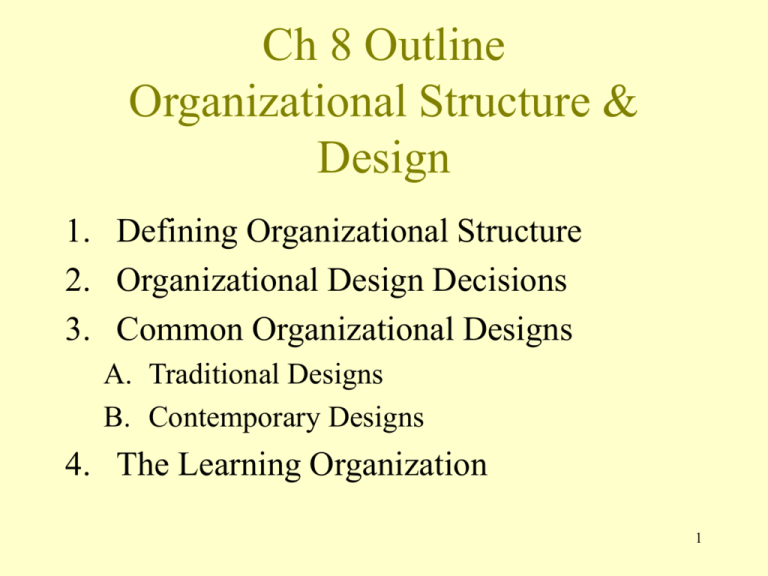
Ch 8 Outline Organizational Structure & Design 1. Defining Organizational Structure 2. Organizational Design Decisions 3. Common Organizational Designs A. Traditional Designs B. Contemporary Designs 4. The Learning Organization 1 Defining Organizational Structure • Organizing – the process of creating an organization’s structure • Organizational structure – the formal framework by which job tasks are divided, grouped and coordinated (often represented by an organizational chart) • Organizational design – the process of developing or changing an organization’s structure – It involves six key elements 2 Organizational Design Involves decisions about six key elements: 1. 2. 3. 4. 5. 6. Work specialization Departmentalization Chain of command Span of control Centralization/decentralization Formalization 3 Departmentalization The way jobs are grouped together: 1. Functional – groups jobs by functions performed 2. Product – groups jobs by the product line 3. Geographical – groups jobs on the basis of territory or geography 4. Process – groups jobs on the basis of product or customer flow 5. Customer – groups jobs on the basis of common customers 4 Span of Control • Refers to the number of subordinates who report directly to an executive or supervisor • The differences in the span of control have direct implications on the shape of the organization – Tall organizations – span of control remains constant, or narrow – Flat organizations – span of control is wide with fewer reporting levels 5 Span of Control • Organizations must find the optimal span of control to be effective – Narrow enough to permit manages to maintain control over subordinates – Wide enough so that the possibility of micromanaging is minimized • The optimal span of control is dependant on the following factors – Is the work clearly defined – Are subordinates highly trained and do they have access to information – Is the manager highly capable and supportive – Are jobs similar and performance measures comparable – Do subordinates prefer autonomy to close supervisory control 6 Decentralization • Organizations in which high-level executives make most decisions and pass them down to lower levels for implementation are known as Centralized organizations • Decentralized organizations allow lower-level managers to make important decisions • Decentralization: – Can speed the decision making process – Allows the people who are most affected by the decision to make the decision – Allows individuals with the most relevant information, and who can best foresee the consequences of the decision, to make the decision 7 Formalization • The degree to which jobs within the organization are standardized. – Standardization – removes the need for employees to consider alternatives • The extent to which employee behavior is guided by rules and procedures. – Explicit job descriptions – Clearly defined procedures 8 Common Organizational Designs • Traditional Designs - Simple Structure – low departmentalization, wide spand of control, authority centralized in a single person, and little formalization - Functional Structure – groups similar or related occupational specialties together (e.g. engineering, accounting, etc.) 9 Common Organizational Designs • Divisional Structure – composed of separate divisions – Each division has limited autonomy – Parent corporation acts as an external overseer to coordinate and control the divisions • Parent corp. also provides support services 10 The Divisional Organization • In a divisional organization, departmentalization will group units around products, customers, or geographic regions 11 Common Organizational Designs • Team-Bases Structures – entire organization is made up of work teams – Employee empowerment is crucial (teams may be selfdirected/managed—no straight-line authority from top down) – Teams are responsible for all work activity and performance – Complements functional or divisional structures in large orgs. – Allows efficiency of a bureaucracy – Provides flexibility of teams 12 The Matrix Organization • A matrix organization is a hybrid form of organization in which functional and divisional forms overlap; managers and staff personnel report to two bosses – a functional manager and a divisional manager 13 The Matrix Organization • Advantages of the Matrix organization include – Decision making is decentralized – Communication networks process large amounts of information – Decentralization keeps higher management from becoming overloaded – Employees learn to collaborate – More career options for employees • Disadvantages of the matrix organization include – Subordinates may become confused regarding their primary responsibility – Power struggle between managers – Thinking that matrix management is the same thing as group decision making – Too much democracy can lead to not enough action 14
